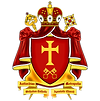 |
|---|
ABOUT THE CHURCH
The Antiochian Orthodox Catholic Apostolic Church, also known as the Antiochian Catholic Apostolic Church, or simply, the Antiochian Church and legally the Antiochian Metropolitanate, is the proper continuation of the Church of Antioch, the second oldest established apostolic—meaning, pertaining to the Apostles of Jesus—church in all existence after the Church of Jerusalem (which has been absorbed into Antiochian jurisdiction alongside the Alexandrian Church in Egypt).
The autocephalous—meaning self-lawed and self-headed, or simply, independent—church of Antioch’s establishment is primarily attributed to Saints Peter, Paul, and John with two jurisdictional churches of the Antiochian Church attributed also to Paul and John (Hierapolis and Smyrna). Saint Peter, First Among Equals, and first metropolitan bishop of the Antiochian Church, consecrated Saint Evodius—one of the first identifiable Christians—as his apostolic successor. After the death of Saint Evodius, Saint Peter chose Ignatius Theophorus-Nurono as his successor. From then on the spiritual brothers of Saint Ignatius in the ordained priesthood, all of whom were students of Apostle John, were chosen as the bishops of the two other episcopal sees: Saint Polycarp appointed to Smyrna after the death of Saint Bucolus, who before him was Saint Strataes, and before him, Saint Apelles, and Saint Papias appointed to Hierapolis where Apostle Phillip is buried. These three holy men are members of the Fathers of the Great and Holy Church.
Historical and theological distinctiveness of the Antiochian Orthodox Catholic Apostolic Church resulted from the series of Arian, semi-Arian, Old Oriental, Orthodox Catholic, and Roman Catholic upheavals and schisms—or, divisions of men—that occurred in the Antiochian Church since the deposition of Saint Eustathius the Great in 330 (AD/CE). The influence of the Church of Constantinople also came as a result, overshadowing the Antiochian Church which resulted in a further gradual process of separation via the supporters of Saint Eustathius, remaining out of the state-sanctioned Imperial Greek Catholic Church of the Roman Empire. Today the following churches claim to be the continuation of the Church of Antioch: the Syriac Maronite Church of Antioch, Melkite Greek Catholic Church, the Syriac Catholic Church, the Syriac Orthodox Church of Antioch, the Greek Orthodox Church of Antioch, and the Antiochian Orthodox Catholic Apostolic Church, among others.
The autocephalous church of Antioch is governed collaboratively by the Apostolic Synod of Antioch. Among them, the Bishop of the Cathedral of Christ the King—or, Ecumenical Metropolitan—has honorary status as First Among Equals, claiming succession through the founders of the Antiochian Church. He is also the First Among Equals within the Ancient Orthodox Catholic Apostolic Church as a whole institution, working alongside the Ecumenical Metropolitan of the Syracusan Orthodox Catholic Apostolic Church—or Syracusan Catholic Apostolic Church—who serves as second among equals.
The Antiochian Orthodox Catholic Apostolic Church has defined its doctrines through the upholding of the Council of Nicaea which Saint Eustathius participated in, in addition to the Ancient Orthodox Catholic Apostolic Statute, and those subordinate canons and decrees of the Great and Holy Apostolic Church of Jesus the Christ. It is guided and protected by the Holy Spirit, and so protected from falling into heresy, as other members of the Ancient Orthodox Catholic Apostolic Church also hold. All beliefs of the church are based on the Holy Bible and Holy Tradition, which have been collectively called the deposit of faith. Formal worship, termed the Antiochian Liturgy or Divine Liturgy of Saint Ignatius, is regulated by church authority, with the Great Mystery—the Eucharist, or Holy Communion—being central in worship.
